
 In most refrigerators, the icemaker is a completely independent appliance that just happens to live inside the freezer. The one exception to this is the gawd-awful flex-tray icemaker that has the refrigerator’s defrost timer built into it making it an integral part of the fridge. All icemakers work with a water fill valve which supplies household water to the icemaker. On most refrigerators, the water fill valve is located down in back, in the compressor service compartment. On Sub-Zero refrigerators and other built-in models, the water fill valve is in front, behind the grill at the floor. This illuminating and inspiring Appliance Tip of the Day will answer all your burning questions about the humble, yet ever-so crucial icemaker.
In most refrigerators, the icemaker is a completely independent appliance that just happens to live inside the freezer. The one exception to this is the gawd-awful flex-tray icemaker that has the refrigerator’s defrost timer built into it making it an integral part of the fridge. All icemakers work with a water fill valve which supplies household water to the icemaker. On most refrigerators, the water fill valve is located down in back, in the compressor service compartment. On Sub-Zero refrigerators and other built-in models, the water fill valve is in front, behind the grill at the floor. This illuminating and inspiring Appliance Tip of the Day will answer all your burning questions about the humble, yet ever-so crucial icemaker.
Q. How do icemakers work?
A. All icemakers are based on a fundamental thermodynamic property of water where, below 32ºF (or, for those of you trapped in a communist country, that’s 0ºC), water becomes a solid that we Ameedicans call ice and those infernal godless Swedes call früzen glaza.
You want the boring answer? Ok. First, the icemaker signals the water fill valve to open and allow water to flow into the icemaker tray. Note that the water is not “pumped” in–the only pump in your refrigerator is the compressor and you don’t wanna be drinkin’ what it’s pumpin’, you dig? The water fill valve simply opens and lets water flow in under household water supply pressure. The amount of water that comes into the icemaker is controlled by the icemaker itself.
Once the tray is full, the water sits there until the thermodynamic state change from a liquid to a solid occurs (that means “until it freezes” but it was more fun to say it thata way). When the water tray thermostat senses the ice tray has reached a certain temperature, it starts the harvest cycle–that’s when it dumps the ice into your bucket. This keeps on going until so much ice mounds up that it raises the metal arm on the side of the icemaker. Then the icemaker stops until you use up some of the ice.
Here’s a bonus Fun Fact to Know and Tell: icemakers won’t make ice if the freezer temperature is above 17ºF (that’s -8ºC for you pinko-commies). So, if your icemaker stops making ice, the first thing to check is the freezer temperature because it could be an early warning that there’s something wrong with your fridge, such as a defrosting system failure.
Q. Why do my ice cubes smell or taste bad?
A. Impurities in the water, dirty fridge, old ice…these are just a few of the reasons your ice can smell or taste foul.
Try cleaning out your freezer once in a while. You’d be amazed at the oozing crud you’ll find lurking in there underneath all that frozen stuff that’s been in there for years. Sanitize the inside of the freezer with an antibacterial cleanser. Throw out all those old fad diet food packs that taste like the bottom of my shoe and all those semi-melted pop-sickles and cans of orange juice concentrate. As a bonus, you’ll probably find you won’t get sick as often.
Use a filter to clean up the water–garbage in, garbage out. Here’s a newsflash: all water has some impurities in it, even water that tastes fine when you drink it. But when you freeze this same water into ice cubes, these impurities are magnified and can become noticeable, sometimes disgustingly so. So, even if the water in your house tastes good when you drink it, this same water can make stinky ice. Come git you a water filter.
Q. How long can I ignore changing the water filter for my icemaker?
A. This really depends on the strength of your body’s immune system. You see, as the filter removes the impurities from your water, it not only becomes saturated with those very impurities, but it is transformed into a veritable metropolis for bacteria. These little creatures multiply and grow to such an enormous extent that they actually begin to clog up the filter with their dead corpses. New little bacteria babies begin living and feasting on the rotting corpses of their fallen parents and cousins, clogging the filter, causing low water pressure, and the resulting hollow ice cubes. At this point in the filter’s life, millions of dead and living bacteria, the mixture variously called scum or puss, normally not visible but in extreme cases may cause the ice cubes to appear cloudy, begin sloughing off and traveling with the water to your icemaker. As you use the ice, you ingest these little creatures where they attempt to make their new home deep inside your intestines. The results could range from simply bad tasting ice, to a feeling of a sour stomach, to mild nausea, to violently vomiting up the entire contents of your stomach along with much bile and other slimy secretions.
For optimal ice quality and minimum health effects, change your icemaker water filter at least every six months.
Q. Why won’t my icemaker make ice?
A. I dunno–mine works fine so I’m all set, thanks. But you might try reading through the diagnostic guide in the icemaker diagnostic section. I know, I know, I’m always telling you to read stuff. Sorry about that. I’m still waiting for Microsoft to come out with those new electrodes that you shove deep into your skull and then plug into your computer so you can download stuff from the internet directly into that fermented brown mush ‘twixt your ears. Hope you don’t get one o’ them nasty viruses. Ahh-CHOO!
Q. Can I add an icemaker to my refrigerator/freezer?
A. Ya sure, ya betcha! Picking out the right kit for your fridge can be a little confusing so let this venerable Appliance Tip of the Day be your guiding light through the maze of choices. As a special bonus to my loyal grasshoppers, brand-spankin’ new icemakers are on sale now through August 22, 2004–come git you one!
And, hey, if you need help installing your new icemaker and even a new water supply line for it, we got installation help for you ratcheer, Hoss.
For more pearls of wisdom on icemakers, click here.





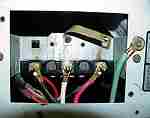

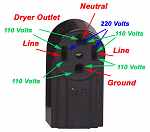

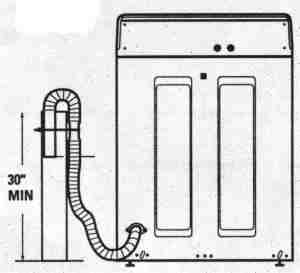 One cause for siphoning is simply that the drain hose discharge is below the fill level of the washer tub. This picture shows the minimum drain height needed to avoid siphoning.
One cause for siphoning is simply that the drain hose discharge is below the fill level of the washer tub. This picture shows the minimum drain height needed to avoid siphoning. 



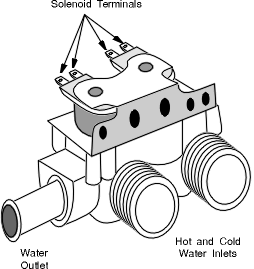 Here’s a typical two-solenoid inlet valve. This is the most common, although some Whirlpools use a three solenoid arrangement and front loaders get even more funky, but the diagnosis and correction are the same. Most of the time, what happens is that sediment builds up on the inlet screen of the solenoid valve and restricts the water flow into the valve.
Here’s a typical two-solenoid inlet valve. This is the most common, although some Whirlpools use a three solenoid arrangement and front loaders get even more funky, but the diagnosis and correction are the same. Most of the time, what happens is that sediment builds up on the inlet screen of the solenoid valve and restricts the water flow into the valve.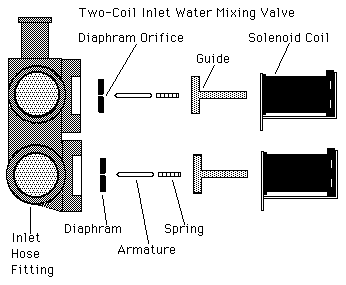 What happens next, though, is a sad tale to tell. Y’see, after a while, the innards of the valve get so gunked up with sediment that the valve can no longer stop the flow of water when it’s supposed to (like, when the washer is unplugged). You can see here that they’s a whole buncha delicate leetle bitty parts in there, da, comrade? Little, itty-bitty pieces of dirt and pipe scale can stick that plunger guide wide-ace open. So, water just keeps on flowing into the washer. Meanwhile, you’re outside playing frisbee with the dog, knockin’ back a fohty of Old Milwaukee and the gottdayam washer overfills making one helluva mess in your house. All cause o’ that stupid plumber’s trick. Now, how smart was that to call in a plumber to do an appliance tech’s job?
What happens next, though, is a sad tale to tell. Y’see, after a while, the innards of the valve get so gunked up with sediment that the valve can no longer stop the flow of water when it’s supposed to (like, when the washer is unplugged). You can see here that they’s a whole buncha delicate leetle bitty parts in there, da, comrade? Little, itty-bitty pieces of dirt and pipe scale can stick that plunger guide wide-ace open. So, water just keeps on flowing into the washer. Meanwhile, you’re outside playing frisbee with the dog, knockin’ back a fohty of Old Milwaukee and the gottdayam washer overfills making one helluva mess in your house. All cause o’ that stupid plumber’s trick. Now, how smart was that to call in a plumber to do an appliance tech’s job?